Metal roofs can be energy savers. Light colors reflect summer heat. Dark hues absorb winter sunlight. Proper color choice cuts energy use. Metal roofing costs more upfront. Long-term savings make it efficient. Metal roofs outperform asphalt. Longevity is another key benefit.
Cool roofs save energy bills. pick light colors like white. They reflect sun’s heat. dark roofs absorb heat. what color metal roof is most energy efficient? light colors win. white is best. install a white metal roof.
Metal roofs offer energy savings. Color choice impacts efficiency, with light shades reflecting summer rays and dark tones, like a black metal roof a bad idea, absorbing winter sunshine. Proper color selection is crucial for maximizing cost savings based on climate and home location.
Key Takeaways
- White, light gray, and pastels are most energy-efficient.
- Reflect more sunlight, absorb less heat.
- Enhance reflective properties.
- Radiate absorbed heat effectively.
- Reduce cooling costs, ideal for warm climates.
- Less efficient, absorb more heat, increase cooling costs.
Colored Metal Roofing
Colored metal roofing offers many benefits. Light colors like white and light gray reflect sunlight. This keeps your home cooler. Cool roof coatings boost this effect. They help lower energy bills. Light-colored roofs work best in sunny places.
Dark-colored roofs absorb more heat. This leads to higher cooling costs. Light colors also have better thermal emittance. They release heat more efficiently. Choose light colors for energy savings. Your home will stay comfortable and cool.
White Metal Roofing
White metal roofing is a top choice for energy efficiency. It reflects sunlight well and keeps buildings cool. This reduces the need for air conditioning. Homeowners save money on energy bills. White roofs help in hot climates. They make a noticeable difference.
These roofs also last long. The coating protects against weather and rust. White metal roofs need less maintenance. They stay cleaner compared to darker roofs. This choice benefits both the environment and the wallet. White roofs are smart and practical.
White Tin Roofing

White tin roofing is very energy-efficient. It reflects more sunlight than darker roofs. This keeps your home cooler. You will use less energy for air conditioning. It saves money and reduces your carbon footprint. White roofs also have cool roof coatings to boost reflectivity.
Thermal emittance is high with white tin roofs. They release absorbed heat effectively. This helps maintain a comfortable indoor temperature. They work best in warm, sunny climates. White tin roofing is a smart choice for energy savings. It is practical and eco-friendly.
Metal Roof Colors Chart
A metal roof color chart helps you choose the best color for your roof. Light colors like white, light gray, and pastels are the most energy-efficient. These colors reflect sunlight and keep your home cooler. This helps reduce your cooling costs. They also often come with cool roof coatings for extra efficiency.
Dark colors like black or dark brown absorb more heat. This can increase cooling costs, especially in sunny areas. If you want an energy-efficient roof, pick a light color. A good color choice keeps your home comfortable and saves money. Make your choice wisely using a color chart.
Standing Seam Metal Roof Colors
Standing seam metal roofs come in many colors. Light colors like white and light gray are the most energy efficient. These colors reflect sunlight and keep homes cooler. They help lower cooling costs. Light roofs often have cool coatings that boost efficiency.
Dark colors like black and dark brown look sleek but absorb more heat. This can increase cooling costs. Dark roofs suit cooler climates better. Choosing the right color affects your home’s energy use and comfort. Light colors are best for saving energy in warm areas.
Tin Roof Colors

Tin roofs come in various colors, but for energy efficiency, lighter shades like white, light gray, or soft pastels are best. These colors reflect more sunlight and absorb less heat, helping to keep your home cooler in hot weather. Many tin roofs also come with cool roof coatings that further enhance their reflective properties.
These coatings make the roof more efficient at reducing cooling costs, especially useful in sunny climates where heat absorption can be a concern. In contrast, darker colors absorb more heat and can lead to higher cooling bills, making them less energy-efficient choices for tin roofs.
Metal Standing Seam Roof Colors
Metal standing seam roofs come in various colors. Light shades like white, light gray, and pastels are the most energy-efficient. They reflect sunlight and absorb less heat, reducing cooling costs. Many roofs also feature cool coatings that enhance their reflectivity.
These coatings help in radiating absorbed heat effectively, making them ideal for warm climates. On the other hand, dark colors absorb more heat and increase cooling expenses. For optimal energy efficiency, choosing a light-colored standing seam metal roof is recommended.
Most Energy-Efficient Metal Roof Colors
Light colors like white, light gray, and pastels are the best for energy efficiency. They reflect sunlight and absorb less heat. Cool roof coatings improve their reflectivity and help radiate absorbed heat effectively. This can lower cooling costs, especially in warm climates. Conversely, dark colors absorb more heat and increase cooling expenses, making them less efficient.
What Is The Most Energy-Efficient Metal Roof Color?
Light colors like white and pastels are the most energy-efficient for metal roofs. They reflect sunlight, keeping buildings cooler and reducing the need for air conditioning.
Top 3 Most Energy-Efficient Metal Roof Colors
The top three most energy-efficient metal roof colors are white, light gray, and pastels. These colors reflect sunlight effectively, reducing cooling costs and maintaining cooler indoor temperatures. Darker colors absorb more heat, increasing cooling expenses in warmer climates.
How To Choose The Best Metal Roof Color For Energy Efficiency?
To choose the best metal roof color for energy efficiency, opt for light colors like white or light gray. These colors reflect sunlight effectively, keeping your home cooler and reducing cooling costs, especially in warm climates.
Metal Roofing Insulation

Metal roofing insulation is crucial for energy efficiency. Insulating your roof with materials like foam or fiberglass helps regulate indoor temperatures by preventing heat loss in winter and heat gain in summer. This reduces reliance on heating and cooling systems, lowering energy bills.
How To Insulate A Metal Roof?
Insulating a metal roof involves installing insulation materials like foam boards or reflective barriers directly under the roof. Reflective barriers reflect radiant heat, while foam boards provide thermal resistance, keeping buildings warmer in winter and cooler in summer.
Importance Of Insulation For Metal Roofs
Insulation is crucial for metal roofs to regulate indoor temperatures and reduce energy costs. It helps in maintaining comfortable temperatures by preventing heat loss in winter and heat gain in summer, making buildings more energy-efficient.
Types Of Insulation For Metal Roofs
Insulating metal roofs commonly involves using materials like fiberglass batts or spray foam, which provide effective thermal barriers. Fiberglass is easy to install between roof joists, while spray foam fills gaps for better coverage and higher insulation value.
Frequently Asked Questions
What Color Roof Is Most Energy-Efficient?
Light-colored roofs like white or light gray are the most energy-efficient, reflecting sunlight and reducing cooling costs.
What Color Metal Roof Lasts The Longest?
Light-colored metal roofs, such as white or beige, typically last the longest due to better heat reflection and less thermal stress.
What Color Metal Roof Reflects The Most Heat?
Light colors such as white and pastels reflect the most heat on metal roofs, reducing cooling costs and keeping buildings cooler.
Conclusion
Selecting the right color for a metal roof can significantly impact energy efficiency. Light colors like white and light gray reflect more sunlight, reducing cooling costs in warm climates. They are complemented by cool roof coatings that enhance reflectivity and heat emission.
Conversely, dark colors absorb more heat, potentially increasing cooling expenses. For those aiming to optimize energy savings and maintain comfortable indoor temperatures, choosing a light-colored metal roof with appropriate coatings is the optimal choice.











